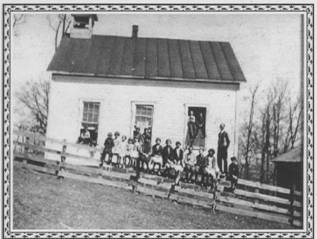 |
Photo Above– Watson Ridge School, Apex Rd., courtesy of Jean Miller, her husband Allen is in the photo.
Cover of book - Springfield Township School Ledger, 1839 – 1857
The Bergholz Story, author, Call, published by Featheringham, pp. 42-45, School Days, Chapter III - The community of East Springfield built a schoolhouse soon after the village was laid out and John Gillis was known to have taught there as early as 1814. During this same year the first log schoolhouse was erected in the Brush Creek area. The building was located in section 2, about 20 rods east of the present site of Chestnut Grove Church. The first teacher was Samuel Clark, father of the Rev. Dr. Alexander Clark, who became a prominent minister in the Methodist Church as well as a writer. Samuel Clark was engaged as schoolmaster at $10 a month for four months by Matthew Russell and Moses Marshall and boarded free with the latter.
In 1830 the school district was regularly organized. The first election for school officers was held at the house of Martin Adams on September 8, choosing Samuel Clark as Clerk, John Adams, William Kerr, and Elisha Brooks, directors; Martin Adams, treasurer. The idea of a new schoolhouse for the Brush Creek community met with great enthusiasm. People turned out in such numbers and worked with such energy that the building took only one day to construct… James Clark and Charles Marshall were the architect and boss carpenter. During the construction of the building, 23 gallons of whiskey were consumed. Had the settlers looked forward 15 years, it is interesting to note that this schoolhouse required $32.00 of cash and 23 gallons of whiskey to build would also be the site of the first temperance meeting in this area. Teachers came and went for half a century and at least until 1947 the old log schoolhouse stood perched on its corner of the barren, yellow soil as in early times.
The first schoolhouse in Ross Township was also built about 1814 and was located about half a mile southeast of Stephen Coe’s mill near Mooretown. James Ewing was the first teacher with a three-month term. A Mr. Shane writes that early schools were often not so fortunate as to have a schoolhouse. They "were often taught on subscription and a teacher would get to use of some cabin outbuilding or a farmer’s kitchen in which to hold his school. He would seat in a very primitive way, but it served his purpose…"

{Above - The Second Street School built in 1902 called, “Marching out an noon.”}
The early teachers were all persons of very common scholarship and included Mr. Dixon, Thomas Riley, Mr. Baker, Henry Crabs and Samuel McCutheon. The schools were held sometimes one month, sometimes three, according to the money raised. They were kept in the winter, but seldom in the summer. The predominating religious influence being Presbyterian, the parents were encouraged by the ministers to educate their children. About 1820, under a then new law, townships were districted and school houses built; but still the distilleries outnumbered the schoolhouses four to one.
Dr. Shilling, in the first chapter of his book, Yellow Creek Stories, provides a description of what many of the early log schoolhouses must have looked like. "It was approximately 18 feet square, rough ceiling and six small windows. A huge fireplace faced the schoolmaster. Outside the doorway was small and deep, due to the thickness of the oaken and mortar walls."
The first school in Bergholz, Ohio was located on Third Street in the red store building near Charles Gerveson’s home. It was later remodeled by Gordon’s for a buggy shop and still later became a furniture store. Classes were also reported held in the building next door, which burned. Due to the increase in school population at both Amsterdam and Bergholz, the two communities were set off as special school districts, and a four-room building was erected on Second Street in 1902. This school housed grades 1 – 8. Two additional rooms were added.
In 1909, a third grade high school was established, offering students the opportunity to acquire the freshmen and sophomore years of high school in their home community. One Professor Calderhead was in charge of this high school with the first class graduating in 1911. In order to gain the junior and senior years of high school, students took the train to Minerva, Salineville or Jewett. A first grade high school was developed, occupying both back upstairs rooms in the school. Now students came from Amsterdam and other area communities to obtain their four-year high school diplomas at Bergholz.

Bergholz First Graduating Class – 1911 L to R, Row 1: Thurman Critser, Mary Hackathorn, Gay Smyth. Row 2: Norman Summers, Arlie Calderhead, Dean Carson, Guy Allen, Forest Henderson.
1890’s Class at Bergholz First School on Third Street. Row 1: Iva Hackathorn, A Metz Girl, Laura Kelly, George Morrow, Ralph Allison, Pearl Morrow, Harry Marshall, Clyde McCullough, Joe Hess, Herman Robbins. Row 2: Lea Allison, Myrtle Gordon, Clara Nesbitt, Prof. Brogan, Unknown, Wayne Gordon. Row 3: An Allison Girl, Annie Barkley, Lizzie Wright, Cora Moore, Molly Morrow, Sadie Robbins, An Allison Girl.
Before the turn of the century, we should also note that Bergholz had an Academy, which provided a means of higher education before the third and first grade high schools were established.